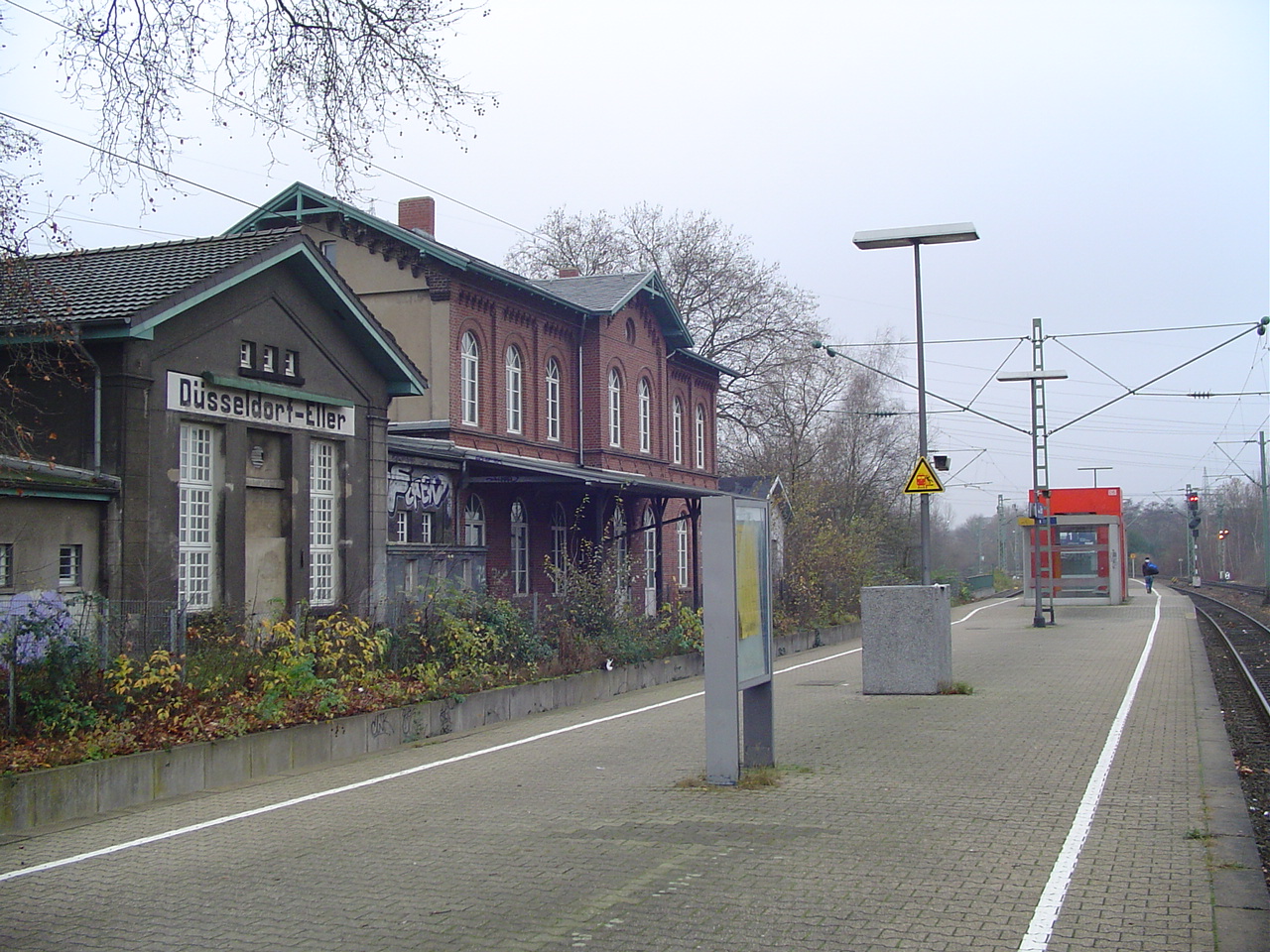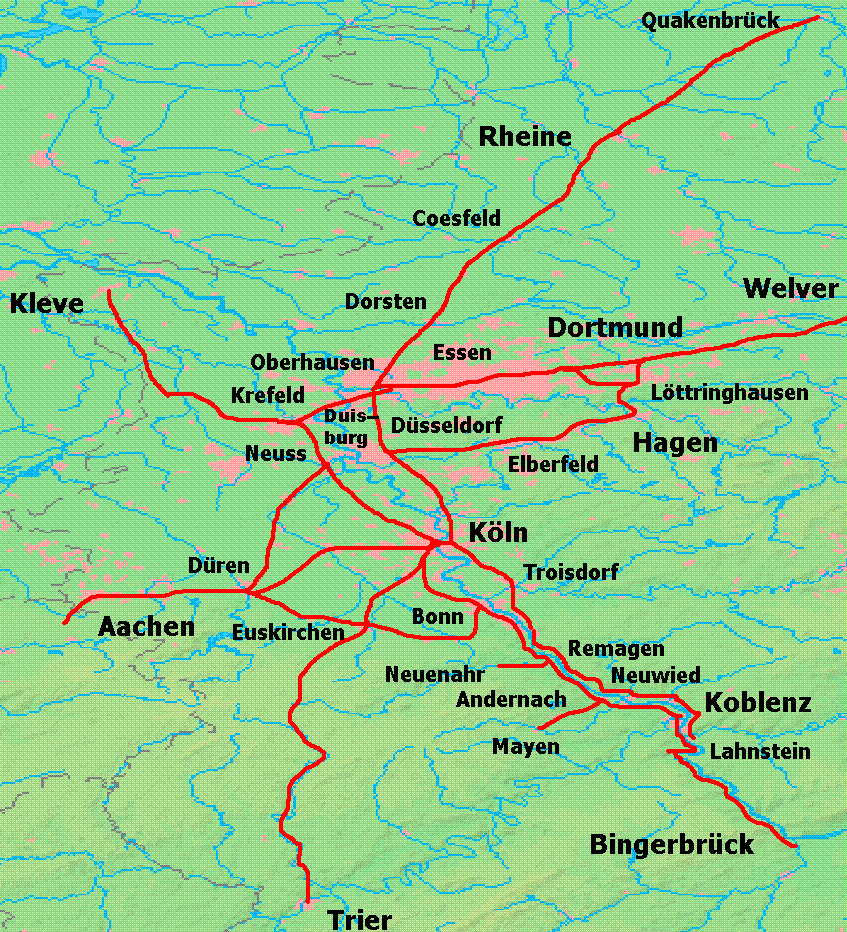|
Düsseldorf–Solingen Railway
The Düsseldorf–Solingen railway is a railway in the German state of North Rhine-Westphalia. It is a 19 kilometre line, entirely double track and electrified with overhead line. It is now exclusively used by line S 1 of the Rhine-Ruhr S-Bahn. History The section between Düsseldorf Hauptbahnhof and Düsseldorf-Eller was opened on 1 October 1891 by the ''Eisenbahndirektionen Cöln rechtsrheinisch'' ( Railway division of Cologne Rhine Right Bank of the Prussian state railways). Between Eller and Hilden the line originally used the Troisdorf–Mülheim-Speldorf line, which was opened by the Rhenish Railway Company on 18 November 1874, but separate tracks were opened in 1917. The section between Hilden and Ohligs (now Solingen Hauptbahnhof) was opened on 3 January 1894. Rail services S-Bahn services started operating over the line to Düsseldorf Airport Terminal on 27 October 1975; these services were eventually branded as line S 7. On 13 December 2009, line S 7 services we ... [...More Info...] [...Related Items...] OR: [Wikipedia] [Google] [Baidu] |
15 KV AC Railway Electrification
Railway electrification systems using at are used on transport railways in Germany, Austria, Switzerland, Sweden, and Norway. The high voltage enables high power transmission with the lower frequency reducing the losses of the traction motors that were available at the beginning of the 20th century. Railway electrification in late 20th century tends to use AC systems which has become the preferred standard for new railway electrifications but extensions of the existing networks are not completely unlikely. In particular, the Gotthard Base Tunnel (opened on 1 June 2016) still uses 15 kV, 16.7 Hz electrification. Due to high conversion costs, it is unlikely that existing systems will be converted to despite the fact that this would reduce the weight of the on-board step-down transformers to one third that of the present devices. History The first electrified railways used series-wound DC motors, first at 600 V and then 1,500 V. Areas with 3 kV ... [...More Info...] [...Related Items...] OR: [Wikipedia] [Google] [Baidu] |
Wuppertal-Oberbarmen–Solingen Railway
The Wuppertal-Oberbarmen–Solingen railway is a line in the Bergisches Land in the German state of North Rhine-Westphalia, which connects the three Bergisch cities of Wuppertal, Remscheid and Solingen. It is classified as a main line and is double track and non-electrified. Today's route is made up largely of sections of three formerly independent routes built by the Bergisch-Märkische Railway Company (german: Bergisch-Märkische Eisenbahn-Gesellschaft, BME). The section between Remscheid and Solingen was built after the BME's nationalisation by the Prussian state railways. History The modern line between Solingen and Wuppertal includes several sections that originally formed parts of several independent lines: *the Solingen–Wuppertal-Vohwinkel railway, *the Wuppertal-Oberbarmen–Opladen railway, *the Lennep–Hasten railway. The section between Remscheid and Solingen was built after the BME's nationalisation by the Prussian state railways. Ohligs Wald–Solingen (We ... [...More Info...] [...Related Items...] OR: [Wikipedia] [Google] [Baidu] |
Verkehrsverbund Rhein-Ruhr
The Verkehrsverbund Rhein-Ruhr (), abbreviated VRR, is a public transport association (Verkehrsverbund) in the German state of North Rhine-Westphalia. It covers most of the Ruhr area, as well as neighbouring parts of the Lower Rhine region, including Düsseldorf and thus large parts of the Rhine-Ruhr conurbation. It was founded on 1 January 1980, and is Europe’s largest body of such kind, covering an area of some with more than 7.8 million inhabitants, spanning as far as Dorsten in the north, Dortmund in the east, Langenfeld in the south, and Mönchengladbach and the Dutch border in the west. Structure and responsibilities The VRR is tasked with coordinating public transport in its area. This means the following: * setting and developing the fare system (“VRR-Tarif”) ** redistributing ticket revenue onto the transport companies * coordinating local train services (''Schienenpersonennahverkehr'', SPNV) within its area as public service obligations (PSO) * integrating the ... [...More Info...] [...Related Items...] OR: [Wikipedia] [Google] [Baidu] |
Wuppertal
Wuppertal (; "''Wupper Dale''") is, with a population of approximately 355,000, the seventh-largest city in North Rhine-Westphalia as well as the 17th-largest city of Germany. It was founded in 1929 by the merger of the cities and towns of Elberfeld, Barmen, Ronsdorf, Cronenberg and Vohwinkel, and was initially "Barmen-Elberfeld" before adopting its present name in 1930. It is regarded as the capital and largest city of the Bergisches Land (historically this was Düsseldorf). The city straddles the densely populated banks of the River Wupper, a tributary of the Rhine called ''Wipper'' in its upper course. Wuppertal is located between the Ruhr (Essen) to the north, Düsseldorf to the west, and Cologne to the southwest, and over time has grown together with Solingen, Remscheid and Hagen. The stretching of the city in a long band along the narrow Wupper Valley leads to a spatial impression of Wuppertal being larger than it actually is. The city is known for its steep ... [...More Info...] [...Related Items...] OR: [Wikipedia] [Google] [Baidu] |
Remscheid Hauptbahnhof
Remscheid Hauptbahnhof is a railway station in the Bergisch city of Remscheid in the German state of North Rhine-Westphalia. It is located in Willy-Brandt-Platz near central Remscheid and is classified by Deutsche Bahn as a category 5 station. Remscheid and Gevelsberg Hauptbahnhof are the only Hauptbahnhof stations in Germany to be served only by S-Bahn trains. History On 1 September 1868, the Bergisch-Märkische Railway Company () opened the first section of the Rittershausen–Opladen line from Oberbarmen (then called Rittershausen) to Lennep, together with a branch line to Remscheid, giving the city its first rail connection. Remscheid station (now called ''Remscheid Hauptbahnhof'') and its attached buildings were built of timber. A branch line to Hasten was opened on 1 September 1883, and the Lennep–Remscheid line was duplicated up to 1891. Five years later, a branch to Bliedinghausen was added, but has only ever been used for freight. As part of the construction ... [...More Info...] [...Related Items...] OR: [Wikipedia] [Google] [Baidu] |
DBAG Class 422 trains. The inner carriages are called Class 432. Following a timetable change in Dec ...
The Class 422 is a series of four-car electric multiple units that are a derivative of the DBAG Class 423. The two inner cars in the set are designated as Class 432 vehicles. History The units were commissioned by Deutsche Bahn in 2005. 78 units worth euro, €343 million were built by Bombardier Transportation and Alstom and delivered between March 2008 and October 2010. They are now used in such places as like on the Rhine-Ruhr S-Bahn which operate in cities like Köln and Düsseldorf as well as the Ruhr area. Deutsche Bahn uses the units on the Rhine-Ruhr S-Bahn network, unlike most S-Bahn Networks which use similar DBAG Class 423 The Deutsche Bahn Class 423 EMU is a light-weight articulated electric railcar for S-Bahn commuter networks in Germany. The train has similar dimensions to its predecessor, the Class 420 EMU, but is significantly lighter and has one large passe ... [...More Info...] [...Related Items...] OR: [Wikipedia] [Google] [Baidu] |
S7 (Rhine-Ruhr S-Bahn)
Line S 7 is an S-Bahn line on the Rhine-Ruhr network in the German state of North Rhine-Westphalia, which has been operated by VIAS GmbH from Wuppertal Hauptbahnhof to Solingen Hauptbahnhof since 15 December 2013. It is operated at 20-minute intervals, using LINT 41 vehicles. The service was previously classified as Regionalbahn service RB 47, known as the ''Der Müngstener'', a reference to the Müngsten Bridge, which it crosses and DB Regio had operated it on the same route with class 628 diesel multiple units since 1994. It was also operated at 20-minute intervals, in the evenings and on weekends, every 30 minutes. Line S 7 runs over lines built by two railway companies: * from Wuppertal Hauptbahnhof to Wuppertal-Oberbarmen station over the Elberfeld–Dortmund railway, opened by the Bergisch-Märkische Railway Company in 1847 and 1849, * from Wuppertal-Oberbarmen to Solingen Hauptbahnhof over the Wuppertal-Oberbarmen–Solingen railway, opened in sections by the Bergisch- ... [...More Info...] [...Related Items...] OR: [Wikipedia] [Google] [Baidu] |
Düsseldorf Airport Terminal Station
Düsseldorf Airport Terminal (''Düsseldorf Flughafen Terminal'') is an underground station on the Rhine-Ruhr S-Bahn at the end of the Düsseldorf-Unterrath–Düsseldorf Airport Terminal railway, situated underneath Terminal C of Düsseldorf Airport, Düsseldorf Düsseldorf ( , , ; often in English sources; Low Franconian and Ripuarian: ''Düsseldörp'' ; archaic nl, Dusseldorp ) is the capital city of North Rhine-Westphalia, the most populous state of Germany. It is the second-largest city in th ... in western Germany. It is served by the S11 line. The station was opened in 1975 and was served by S-Bahn line S 7 until 13 December 2009, when line S 7 was closed and S 11 was extended to Düsseldorf Airport Terminal station. Notes Railway stations in Düsseldorf Railway stations located underground in Germany Rhine-Ruhr S-Bahn stations Airport railway stations in Germany S11 (Rhine-Ruhr S-Bahn) Düsseldorf Airport Railway stations in Germany opened in 1975 ... [...More Info...] [...Related Items...] OR: [Wikipedia] [Google] [Baidu] |
Rhenish Railway Company
The Rhenish Railway Company (German language, German: ''Rheinische Eisenbahn-Gesellschaft'', RhE) was along with the Cologne-Minden Railway Company (CME) and the Bergisch-Märkische Railway Company (BME) one of the railway companies that in the mid-19th century built the first railways in the Ruhr and large parts of today's North Rhine-Westphalia. Foundation The industrialists of the Rhineland and the Bergisches Land, then part of Prussia, sought to avoid paying the high tolls for using the Rhine imposed by the Netherlands and very early in its development, saw the possibility of the new means of transport, the railway. As early as the 1830s committees were established the cities of the Rhineland to promote proposals for building railways. Some of the members of the Cologne committee under David Hansemann (1790–1864)—a merchant and banker from Aachen—and the Aachen Committee favoured a railway line through Belgium to the seaport of Antwerp via Liege. Belgium, which had bee ... [...More Info...] [...Related Items...] OR: [Wikipedia] [Google] [Baidu] |
Prussian State Railways
The term Prussian state railways (German: ''Preußische Staatseisenbahnen'') encompasses those railway organisations that were owned or managed by the State of Prussia. The words "state railways" are not capitalized because Prussia did not have an independent railway administration; rather the individual railway organisations were under the control of the Ministry for Trade and Commerce or its later offshoot, the Ministry for Public Works. The official name of the Prussian rail network was ''Königlich Preußische Staatseisenbahnen'' (K.P.St.E., "Royal Prussian State Railways") until 1896, ''Königlich Preußische und Großherzoglich Hessische Staatseisenbahn'' (K.P.u.G.H.St.E., " Royal Prussian and Grand-Ducal Hessian State Railways") until the end of the First World War, and ''Preußische Staatsbahn'' (P.St.B., "Prussian State Railway") until its nationalization in 1920. A common mistake is the use of the abbreviation K.P.E.V. in supposed reference to a mythical "Royal Prussian ... [...More Info...] [...Related Items...] OR: [Wikipedia] [Google] [Baidu] |
Railway Divisions In Germany
In Germany and Austria, the running of railway services for a railway administration or the regional network of a large railway company was devolved to railway divisions, variously known as ''Eisenbahndirektionen (ED), Bundesbahndirektionen (BD)'' or ''Reichsbahndirektionen (RBD/Rbd)''. Their organisation was determined by the railway company concerned or by the state railway and, in the German-speaking lands at least, they formed the intermediate authorities and regional management organisations within the state railway administration's hierarchy. On the formation of the Deutsche Bahn AG in 1994 the system of railway divisions (''Eisenbahndirektionen'') in Germany was discontinued and their tasks were transferred to new "business areas". Germany State railway divisions Incorporation into the state government The first railway divisions of the various German state railways (known as ''Länderbahnen''), usually reported to a specific government ministry. For example, in Prus ... [...More Info...] [...Related Items...] OR: [Wikipedia] [Google] [Baidu] |







